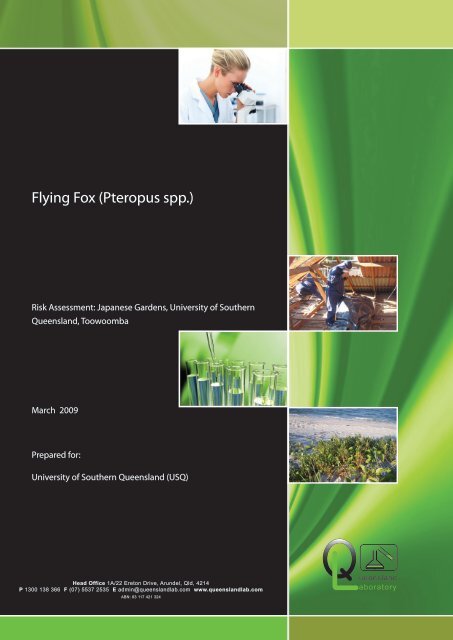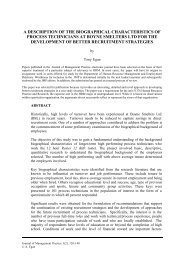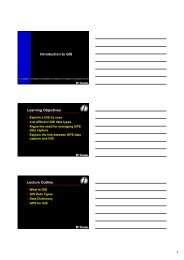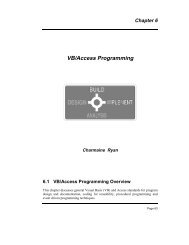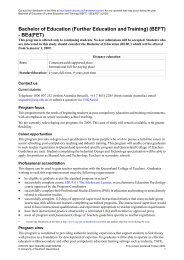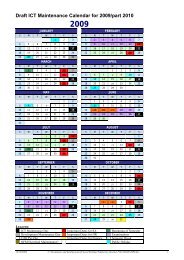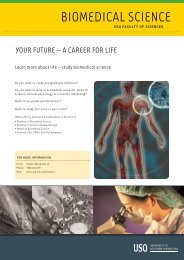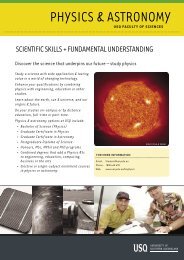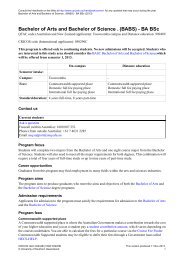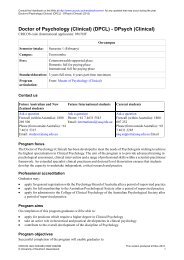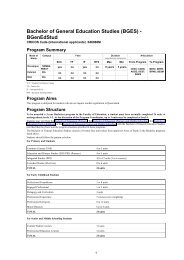3 Information on flying foxes - University of Southern Queensland
3 Information on flying foxes - University of Southern Queensland
3 Information on flying foxes - University of Southern Queensland
Create successful ePaper yourself
Turn your PDF publications into a flip-book with our unique Google optimized e-Paper software.
Flying Fox (Pteropus spp.)<br />
Risk Assessment: Japanese Gardens, <strong>University</strong> <strong>of</strong> <strong>Southern</strong><br />
<strong>Queensland</strong>, Toowoomba<br />
March 2009<br />
Prepared for:<br />
<strong>University</strong> <strong>of</strong> <strong>Southern</strong> <strong>Queensland</strong> (USQ)<br />
Head Office 1A/22 Eret<strong>on</strong> Drive, Arundel, Qld, 4214<br />
P 1300 138 366 F (07) 5537 2535 E admin@queenslandlab.com www.queenslandlab.com<br />
ABN: 83 117 421 324<br />
ueensland<br />
aboratory
DOCUMENT CONTROL RECORD<br />
<strong>Queensland</strong> Laboratory Pty Ltd Job No: MQ08004<br />
Teleph<strong>on</strong>e: 1300 138 366 File reference: MQ08004.1<br />
Facsimile: (07) 5537 2535 Date <strong>of</strong> Issue: 31.03.09<br />
Email: andrew@queenslandlab.com Project Manager: Andrew Thomps<strong>on</strong><br />
Report Details<br />
Title:<br />
Author(s):<br />
Flying Fox (Pteropus spp.) Risk Assessment: Japanese Gardens,<br />
<strong>University</strong> <strong>of</strong> <strong>Southern</strong> <strong>Queensland</strong>, Toowoomba.<br />
Andrew Thomps<strong>on</strong><br />
Status: Issue No. 1/1<br />
Client:<br />
Client C<strong>on</strong>tact:<br />
Synopsis:<br />
The <strong>University</strong> <strong>of</strong> Sothern <strong>Queensland</strong><br />
Pam Crawford<br />
This report presents an initial risk assessment <strong>of</strong> the increasing <strong>flying</strong> fox<br />
populati<strong>on</strong> within the Japanese Gardens located in the grounds <strong>of</strong> the<br />
<strong>University</strong> <strong>of</strong> <strong>Southern</strong> <strong>Queensland</strong>.<br />
Revisi<strong>on</strong> History<br />
Issue No<br />
Date<br />
Issued By<br />
Checked By<br />
Distributed to<br />
No. <strong>of</strong><br />
Copies<br />
1/1 31/03/09 K. O’Hara S. Evans Pam Crawford 1
MQ08004 Flying Fox (Pteropus spp.) Risk Assessment: Japanese Gardens, <strong>University</strong> <strong>of</strong> <strong>Southern</strong> <strong>Queensland</strong>,<br />
Toowoomba.<br />
DISCLAIMER<br />
The management and staff <strong>of</strong> <strong>Queensland</strong> Laboratory Pty Ltd have taken every care in compiling the<br />
informati<strong>on</strong> c<strong>on</strong>tained in their reports. As the interpretati<strong>on</strong> <strong>of</strong> scientific data is <strong>of</strong>ten subject to<br />
pr<strong>of</strong>essi<strong>on</strong>al judgement it is possible that errors may occur.<br />
In c<strong>on</strong>sequence <strong>of</strong> the <strong>of</strong>ten subjective nature <strong>of</strong> the scientific interpretati<strong>on</strong> <strong>of</strong> data, <strong>Queensland</strong><br />
Laboratory Pty Ltd does not guarantee the completeness or accuracy <strong>of</strong> the informati<strong>on</strong> provided and<br />
clients are advised that they should not rely entirely up<strong>on</strong> this informati<strong>on</strong> in their making <strong>of</strong> their<br />
commercial decisi<strong>on</strong>.<br />
Any opini<strong>on</strong>, statement, representati<strong>on</strong> or advice given by or <strong>on</strong> behalf <strong>of</strong> <strong>Queensland</strong> Laboratory Pty<br />
Ltd is given in good faith <strong>on</strong> the basis that <strong>Queensland</strong> Laboratory Pty Ltd, its servants, employees<br />
and agents are not subject to any liability whatsoever (whether by reas<strong>on</strong> <strong>of</strong> lack <strong>of</strong> due care and<br />
attenti<strong>on</strong> or otherwise) and the client releases and discharges <strong>Queensland</strong> Laboratory Pty Ltd and its<br />
servants, agents or employees from all acti<strong>on</strong>s, suits, claims, demands, causes <strong>of</strong> acti<strong>on</strong>, costs and<br />
expenses, legal, equitable, under statute and otherwise, and all other liabilities <strong>of</strong> any nature (whether<br />
or not the parties were or could have been aware <strong>of</strong> them) which the client may have; or but for this<br />
disclaimer, could or might have had, against <strong>Queensland</strong> Laboratory Pty Ltd and its servants, agents<br />
or employees in any way related to the informati<strong>on</strong> provided or the circumstances recited in this<br />
disclaimer or allegati<strong>on</strong>s arising out <strong>of</strong> or in any way related to the informati<strong>on</strong> provided to the client by<br />
<strong>Queensland</strong> Laboratory Pty Ltd.<br />
The informati<strong>on</strong> provided is for the benefit and use <strong>of</strong> the client <strong>on</strong>ly and cannot be relied up<strong>on</strong> by any<br />
third party.<br />
QUEENSLAND LABORATORY<br />
Occupati<strong>on</strong>al Hygiene & Envir<strong>on</strong>mental C<strong>on</strong>sultants<br />
Page 2
MQ08004 Flying Fox (Pteropus spp.) Risk Assessment: Japanese Gardens, <strong>University</strong> <strong>of</strong> <strong>Southern</strong> <strong>Queensland</strong>,<br />
Toowoomba.<br />
TABLE OF CONTENTS<br />
Report Details ......................................................................................................................... 1<br />
Revisi<strong>on</strong> History ..................................................................................................................... 1<br />
1. Project Background ....................................................................................................... 4<br />
2. Scope ............................................................................................................................... 4<br />
3 <str<strong>on</strong>g>Informati<strong>on</strong></str<strong>on</strong>g> <strong>on</strong> <strong>flying</strong> <strong>foxes</strong> ........................................................................................... 5<br />
4. Risk Analysis .................................................................................................................. 7<br />
5. Management Opti<strong>on</strong>s ..................................................................................................... 8<br />
6. C<strong>on</strong>clusi<strong>on</strong> .................................................................................................................... 13<br />
7. References .................................................................................................................... 13<br />
Appendix 1 ............................................................................................................................ 15<br />
QUEENSLAND LABORATORY<br />
Occupati<strong>on</strong>al Hygiene & Envir<strong>on</strong>mental C<strong>on</strong>sultants<br />
Page 3
MQ08004 Flying Fox (Pteropus spp.) Risk Assessment: Japanese Gardens, <strong>University</strong> <strong>of</strong> <strong>Southern</strong> <strong>Queensland</strong>,<br />
Toowoomba.<br />
1. Project Background<br />
<strong>Queensland</strong> Laboratory was commissi<strong>on</strong>ed by the <strong>University</strong> <strong>of</strong> <strong>Southern</strong> <strong>Queensland</strong>,<br />
Toowoomba Campus to c<strong>on</strong>duct an investigati<strong>on</strong> into the implicati<strong>on</strong>s for health and wellbeing<br />
that would result from having a large populati<strong>on</strong> <strong>of</strong> <strong>flying</strong> <strong>foxes</strong> (Pteropus spp.) using<br />
the campus’ Japanese Gardens as a roost.<br />
The Japanese Gardens are located to the north <strong>of</strong> the campus which is located <strong>on</strong> West<br />
Street, Toowoomba. The Japanese Gardens are <strong>of</strong> such a high standard that they are<br />
am<strong>on</strong>gst the top twenty-five Japanese gardens outside Japan and are Toowoomba’s most<br />
significant garden (Mark Flint, pers. comm.). As a result, the gardens attract tourists from all<br />
over Australia and they are <strong>of</strong>ten used for occasi<strong>on</strong>s such as weddings. Although there is no<br />
fee for visiting or holding cerem<strong>on</strong>ies in the gardens, there is a d<strong>on</strong>ati<strong>on</strong> box from which all<br />
proceeds are used in the upkeep <strong>of</strong> the gardens.<br />
Recently a significant populati<strong>on</strong> <strong>of</strong> <strong>flying</strong> <strong>foxes</strong> has been using the Japanese Gardens as a<br />
roost between dawn and dusk. The populati<strong>on</strong> is made up <strong>of</strong> Black <strong>flying</strong> <strong>foxes</strong> (Pteropus<br />
alecto), Grey-headed <strong>flying</strong> <strong>foxes</strong> (Pteropus poliocephalus) and Little red <strong>flying</strong> <strong>foxes</strong><br />
(Pteropus scaputus) (EPA, Mark Flint, pers. comm.). Originally, approximately six individuals<br />
who are believed to have been scouts used the gardens as a roost. At the beginning <strong>of</strong> 2008<br />
there were 700 individuals roosting in the gardens <strong>on</strong> a daily basis and as <strong>of</strong> March 2009 the<br />
populati<strong>on</strong> has swelled to 2,500 individuals; the populati<strong>on</strong> grows noticeably <strong>on</strong> a fortnightly<br />
basis (Mark Flint, pers. comm.). Due to the increasing numbers <strong>of</strong> <strong>flying</strong> <strong>foxes</strong> using the<br />
gardens as a roost site the trees are becoming damaged and starting to look thin, especially<br />
am<strong>on</strong>gst the higher reaches where most <strong>of</strong> the <strong>flying</strong> <strong>foxes</strong> roost. C<strong>on</strong>sequently, it has<br />
become a primary c<strong>on</strong>cern <strong>of</strong> the university that there may be adverse health risks<br />
associated with having 2,500 <strong>flying</strong> <strong>foxes</strong> roosting in the gardens. Similarly, there are further<br />
c<strong>on</strong>cerns that the damage being inflicted <strong>on</strong> the gardens may be irreparable and also that<br />
tourist numbers may decrease resulting in fewer d<strong>on</strong>ati<strong>on</strong>s.<br />
2. Scope<br />
The aim <strong>of</strong> the investigati<strong>on</strong> was to determine the potential envir<strong>on</strong>mental health issues<br />
associated with the bat populati<strong>on</strong> by visiting the site and c<strong>on</strong>ducting a site assessment;<br />
interviewing site pers<strong>on</strong>nel; desktop research and discussi<strong>on</strong> with the relevant authorities.<br />
The informati<strong>on</strong> obtained from this investigati<strong>on</strong> will be used to assess the c<strong>on</strong>trol measures<br />
required to minimise health risks due to potential exposure and associated to the bats.<br />
QUEENSLAND LABORATORY<br />
Occupati<strong>on</strong>al Hygiene & Envir<strong>on</strong>mental C<strong>on</strong>sultants<br />
Page 4
MQ08004 Flying Fox (Pteropus spp.) Risk Assessment: Japanese Gardens, <strong>University</strong> <strong>of</strong> <strong>Southern</strong> <strong>Queensland</strong>,<br />
Toowoomba.<br />
3 <str<strong>on</strong>g>Informati<strong>on</strong></str<strong>on</strong>g> <strong>on</strong> <strong>flying</strong> <strong>foxes</strong><br />
There are four <strong>flying</strong> fox species which are native to Australia. Of these, the Grey-headed<br />
<strong>flying</strong> fox, Black <strong>flying</strong> fox and Little red <strong>flying</strong> fox are found in south east <strong>Queensland</strong> and<br />
have been noted in the Japanese Gardens. Flying <strong>foxes</strong> are c<strong>on</strong>sidered an important part <strong>of</strong><br />
Australian ecosystems as they serve to pollinate flowers and disperse seeds <strong>of</strong> a variety <strong>of</strong><br />
species (Rainforest CRC, 2006). To assist in the recovery <strong>of</strong> the species the Grey-headed<br />
<strong>flying</strong> fox is protected under the Envir<strong>on</strong>mental Protecti<strong>on</strong> and Biodiversity C<strong>on</strong>servati<strong>on</strong> Act<br />
1999 (Crocker et al., 2005). There is a belief that <strong>flying</strong> <strong>foxes</strong> have limited or no predators,<br />
however, Roberts (2006) lists a number <strong>of</strong> species that predate up<strong>on</strong> them. Such species<br />
include “white-bellied sea eagle, Brahimny kites, powerful owls, crows, crocodiles, dingoes,<br />
domestic dogs, <strong>foxes</strong>, goannas and snakes particularly pyth<strong>on</strong>s” (Roberts, 2006).<br />
3.1 Camps<br />
Studies c<strong>on</strong>ducted in south-east <strong>Queensland</strong> have shown that <strong>flying</strong> <strong>foxes</strong> tend to make their<br />
camps in trees approximately ten metres or higher and where urban development is comm<strong>on</strong><br />
and woody vegetati<strong>on</strong> is uncomm<strong>on</strong> (Rainforest CRC, 2006). Furthermore, camps are <strong>of</strong>ten<br />
established where trees fruit reliably due to regular watering regimes to met aesthetic desires<br />
It has also been shown that <strong>flying</strong> <strong>foxes</strong> prefer camp sites which are close to water courses<br />
(Crocker et al., 2005). In favourable c<strong>on</strong>diti<strong>on</strong>s these camps can harbour populati<strong>on</strong>s in the<br />
tens <strong>of</strong> thousands. Moreover, if favourable c<strong>on</strong>diti<strong>on</strong>s persist a specific site can be used for<br />
decades. There are camps that are being used today that were first described in the 1930s<br />
(Rainforest CRC, 2006).<br />
3.2 Public Health<br />
Studies in the past twenty years have discovered that Australian <strong>flying</strong> <strong>foxes</strong> carry a number<br />
<strong>of</strong> viruses which are known to infect people (Hanna et al., 2000, McCall et al., 2000, IICAB,<br />
CFSPH, 2006, Rainforest CRC, 2006). Viruses such as Hendra virus and Menangle virus<br />
cannot be caught directly from bats and are instead transmitted to humans when the virus<br />
emerges in other animals such as horses or pigs (IICAB, CFSPH, 2006). However, it is not<br />
clear how these viruses are transmitted from <strong>flying</strong> <strong>foxes</strong> to such animals.<br />
There is <strong>on</strong>e virus <strong>of</strong> c<strong>on</strong>cern that can be transmitted directly from <strong>flying</strong> <strong>foxes</strong> to humans<br />
and that is the Australian Bat Lyssavirus (ABL) (Hanna et al., 2000, McCall et al., 2000,<br />
Rainforest CRC, 2006). In many ways ABL is very similar to rabies but does have its own<br />
distinguishing characteristics (Hanna et al., 2000, McCall et al., 2000, Roberts, 2006) Since<br />
being described, ABL has been resp<strong>on</strong>sible for the deaths <strong>of</strong> two people. In the first case an<br />
animal handler was bitten by a yellow-bellied sheathtail bat (not a <strong>flying</strong> fox species) and<br />
became sick 4.5 weeks after the incident (Hanna et al., 2000, McCall et al., 2000). In the<br />
sec<strong>on</strong>d case a woman was bitten by a <strong>flying</strong> fox after trying to remove it from a child it had<br />
flown into; the woman first became sick 27 m<strong>on</strong>ths after the incident (Hanna et al., 2000,<br />
McCall et al., 2000). Although it is advised that it is safe practice to assume that all Australian<br />
<strong>flying</strong> <strong>foxes</strong> and bats carry ABL (Hanna et al., 2000) it is actually <strong>on</strong>ly a small percentage <strong>of</strong><br />
the populati<strong>on</strong> that do possess the disease. A study c<strong>on</strong>ducted by McCall et al. (2000)<br />
revealed that just 6% <strong>of</strong> sick <strong>flying</strong> <strong>foxes</strong> c<strong>on</strong>tained ABL while no wild caught <strong>flying</strong> <strong>foxes</strong><br />
returned a positive result for ABL. Other studies have shown that less than 1% <strong>of</strong> the total<br />
populati<strong>on</strong> actually carries ABL. This statistic coupled with the fact that a cut or a bite needs<br />
to be directly infected with saliva means that the risk <strong>of</strong> infecti<strong>on</strong> is very low (Roberts, 2006).<br />
It is recommended that if this does occur that the wound is cleaned thoroughly with soap and<br />
water and that further medical advice be sought (Hanna et al., 2000).<br />
Infected bats generally display depressi<strong>on</strong> but can also be aggressive towards humans and<br />
other bats which are normally out <strong>of</strong> the ordinary. Other symptoms include a reducti<strong>on</strong> in<br />
motor skills and also partial paralysis <strong>of</strong> the hind limbs (McCall et al., 2000). Despite the<br />
QUEENSLAND LABORATORY<br />
Occupati<strong>on</strong>al Hygiene & Envir<strong>on</strong>mental C<strong>on</strong>sultants<br />
Page 5
MQ08004 Flying Fox (Pteropus spp.) Risk Assessment: Japanese Gardens, <strong>University</strong> <strong>of</strong> <strong>Southern</strong> <strong>Queensland</strong>,<br />
Toowoomba.<br />
chance <strong>of</strong> infecti<strong>on</strong> being increased over the birthing seas<strong>on</strong> which occurs in spring and<br />
summer, it has been reported that 97% <strong>of</strong> exposures to c<strong>on</strong>tact with <strong>flying</strong> <strong>foxes</strong> were<br />
provoked by humans and not vice versa. Therefore, even in the birthing seas<strong>on</strong> it would be<br />
highly unusual to have c<strong>on</strong>tact with <strong>flying</strong> <strong>foxes</strong> without directly aggravating them.<br />
Although faeces and urine pose no threat to infecti<strong>on</strong> from ABL, the faeces from <strong>flying</strong> <strong>foxes</strong><br />
may cause another disease known as Histoplasmosis. When the faeces are left to dry out<br />
and enrich the soil a fungus can grow <strong>on</strong> them. When this fungus is disturbed it can become<br />
airborne and be inhaled. In the most severe cases symptoms <strong>of</strong> this disease can mimic<br />
tuberculosis (Mycology Online, 2007). The chances <strong>of</strong> infecti<strong>on</strong> become more probable in<br />
c<strong>on</strong>fined spaces such as caves (C<strong>on</strong>n, 2006).<br />
3.3 Vegetati<strong>on</strong> Damage<br />
As has already become evident in the Japanese Gardens <strong>flying</strong> <strong>foxes</strong> can cause damage to<br />
vegetati<strong>on</strong>. This due to them moving about the trees <strong>of</strong>ten when coming into roost at dawn or<br />
leaving at dusk. The damage that is prominent to the taller trees in the south end <strong>of</strong> the<br />
Japanese Gardens has become evident over the past six m<strong>on</strong>ths and it is feared that the<br />
damage may worsen as numbers increase (Mark Flint, pers. comm.). It is <strong>of</strong>ten the case that<br />
humans recognise the damage being d<strong>on</strong>e to the camp l<strong>on</strong>g before <strong>flying</strong> <strong>foxes</strong> do. Little red<br />
<strong>flying</strong> <strong>foxes</strong> are known to c<strong>on</strong>duct the most damage as they form camps in excess <strong>of</strong><br />
100,000, <strong>of</strong>ten forming tight clusters <strong>of</strong> 30 to a single branch (Roberts, 2006). This can result<br />
in branches to brake <strong>of</strong>f (Roberts, 2006).<br />
3.4 Odour<br />
A noticeable aspect <strong>of</strong> <strong>flying</strong> fox camps is the odour that surrounds the area. This is largely<br />
attributed to the scent used by males to mark their territory (Roberts, 2006) Although initially<br />
it is a c<strong>on</strong>cern for people, with time it is comm<strong>on</strong> to adjust to the odour so that it is not<br />
noticeable anymore (pers. obs, Mark Flint, pers. comm.). Hence, this is generally <strong>on</strong>ly a<br />
c<strong>on</strong>cern when camps are establishing.<br />
3.5 Noise<br />
The noise caused by <strong>flying</strong> <strong>foxes</strong> is at its peak while they are coming in to roost and leaving<br />
to feed. As the time that roosting occurs is approximately 5:00 a.m. (Mark Flint, pers. comm.)<br />
it is probable that residents may have their sleep disturbed. Roberts (2006) outlines that<br />
although the average noise <strong>of</strong> roosting <strong>flying</strong> <strong>foxes</strong> is approximately at the same level as<br />
traffic, levels slightly higher than background noise, while perhaps not enough to wake<br />
people, are enough to cause sleep disturbance whether it is noticed or not. Over a prol<strong>on</strong>ged<br />
period <strong>of</strong> time this can have quite severe impacts <strong>on</strong> both physical and mental health. The<br />
Japanese Gardens are also meant for use by students wanting to come to a quiet area to<br />
study (Mark Flint, pers. comm.). However, due to the high noise being caused by the <strong>flying</strong><br />
<strong>foxes</strong> students are deciding against using the gardens as a study area.<br />
QUEENSLAND LABORATORY<br />
Occupati<strong>on</strong>al Hygiene & Envir<strong>on</strong>mental C<strong>on</strong>sultants<br />
Page 6
MQ08004 Flying Fox (Pteropus spp.) Risk Assessment: Japanese Gardens, <strong>University</strong> <strong>of</strong> <strong>Southern</strong> <strong>Queensland</strong>,<br />
Toowoomba.<br />
4. Risk Analysis<br />
There are many rumours and beliefs with regards to the health risks associated with <strong>flying</strong><br />
<strong>foxes</strong>. Many people believe that they are disease ridden animals and that the chance <strong>of</strong><br />
being infected with <strong>on</strong>e <strong>of</strong> these diseases is quite high (EPA, pers. comm.).<br />
Table 1 below outlines the major risks associated with living in proximity to <strong>flying</strong> <strong>foxes</strong>. Each<br />
risk is rated <strong>on</strong> its severity and likelihood <strong>of</strong> occurrence. There are also some preventative<br />
measures listed to further reduce the likelihood <strong>of</strong> the risks occurring.<br />
Table 1. Risks and preventative measures for living with <strong>flying</strong> <strong>foxes</strong><br />
Risk<br />
C<strong>on</strong>sequen Likelihood Risk Preventi<strong>on</strong><br />
ce<br />
Ranking<br />
ABL High Unlikely Moderate Avoid c<strong>on</strong>tact with bats. If a<br />
bat is showing symptoms <strong>of</strong><br />
ABL c<strong>on</strong>tact QP&WS or a<br />
wildlife handler that has<br />
been appropriately<br />
vaccinated.<br />
Signage is recommended.<br />
Menangle virus High Unlikely Moderate Be aware symptoms arising<br />
in pigs and seek medical<br />
advice.<br />
Hendra virus High Unlikely Moderate Be aware if horses become<br />
ill and be sure to check for<br />
symptoms. Seek medical<br />
advice.<br />
Histoplasmosis<br />
Medium-<br />
High<br />
Unlikely Low Clean droppings and do not<br />
allow to accumulate,<br />
especially in enclosed<br />
areas.<br />
Falling<br />
Low- Unlikely Low Remove sick or dead<br />
branches<br />
Medium<br />
branches.<br />
Disturbed sleep Low Possible Low C<strong>on</strong>duct an acoustic<br />
assessment and determine<br />
suitable mitigati<strong>on</strong><br />
measures<br />
Decline in Medium Almost High Erect signage educating<br />
tourism to USQ<br />
Certain<br />
people about the <strong>flying</strong><br />
<strong>foxes</strong> and try to incorporate<br />
this as part <strong>of</strong> the<br />
experience.<br />
Decline<br />
tourism<br />
Toowoomba<br />
in<br />
to<br />
Low Unlikely Low<br />
Legend:<br />
E = Extreme risk; immediate acti<strong>on</strong> required.<br />
H = High risk; senior management attenti<strong>on</strong> needed.<br />
M = Moderate risk; management resp<strong>on</strong>sibility must be specified.<br />
L = Low risk; manage by routine inspecti<strong>on</strong>s<br />
(refer to appendix 1 for Qualitative Measures <strong>of</strong> Likelihood and C<strong>on</strong>sequence and Corresp<strong>on</strong>ding<br />
Overall Risk Matrix)<br />
QUEENSLAND LABORATORY<br />
Occupati<strong>on</strong>al Hygiene & Envir<strong>on</strong>mental C<strong>on</strong>sultants<br />
Page 7
MQ08004 Flying Fox (Pteropus spp.) Risk Assessment: Japanese Gardens, <strong>University</strong> <strong>of</strong> <strong>Southern</strong> <strong>Queensland</strong>,<br />
Toowoomba.<br />
Although the c<strong>on</strong>sequences for being infected with ABL are high, the chances <strong>of</strong> being<br />
infected are low. Therefore, the overall risk <strong>of</strong> ABL associated with living with <strong>flying</strong> <strong>foxes</strong> is<br />
also low. If a <strong>flying</strong> fox is displaying symptoms such as those described in secti<strong>on</strong> 2.2.1<br />
<strong>Queensland</strong> Parks & Wildlife Services or a wildlife handler that has been vaccinated<br />
accordingly against ABL should be c<strong>on</strong>tacted.<br />
The risk associated with other viruses such as Hendra virus and Menangle virus are also<br />
low; perhaps even lower than the risk associated with ABL as they cannot be transmitted<br />
directly. Horses should be m<strong>on</strong>itored for symptoms such as fever, respiratory problems and<br />
foamy discharge from nose and mouth (NSW DPI, 2005a). Similarly, pigs should be<br />
m<strong>on</strong>itored for decreases in birth rates and increases in stillborn piglets as these can be<br />
symptoms <strong>of</strong> Menangle virus (NSW DPI, 2005b).<br />
While the risks associated with Histoplasmosis are medium to high, the <strong>flying</strong> fox droppings<br />
in the Japanese Gardens are cleaned throughout the day to meet aesthetic desires (Mark<br />
Flint, pers. omm..) and there are no enclosed areas such as caves. Therefore the risk <strong>of</strong><br />
infecti<strong>on</strong> from Histoplasmosis is low.<br />
Small branches falling may occur as individual Grey-headed <strong>flying</strong> <strong>foxes</strong> fly through the trees<br />
and knock sick or dead parts <strong>of</strong> the tree down. This can pose a risk to people walking in the<br />
gardens however the level <strong>of</strong> risk is very low. This risk level increases to medium however<br />
when there is the possibility <strong>of</strong> larger branches falling <strong>on</strong> people. This may be caused by<br />
Little Red <strong>flying</strong> <strong>foxes</strong> overcrowding branches and causing them to snap. However, as there<br />
have <strong>on</strong>ly been a small number <strong>of</strong> Little red <strong>flying</strong> <strong>foxes</strong> observed in the gardens (EPA, Mark<br />
Flint, pers. omm..), the chance <strong>of</strong> this happening is low unless the populati<strong>on</strong> <strong>of</strong> this<br />
species increases dramatically.<br />
The risk associated with sleep disturbance is c<strong>on</strong>sidered low and the most likely possible<br />
short term effects would include fatigue, exhausti<strong>on</strong> and general annoyance. However, it has<br />
been shown that this can have severe impact <strong>on</strong> physical and mental health over prol<strong>on</strong>ged<br />
periods <strong>of</strong> time (Roberts, 2006). To alleviate this problem, sound barriers such as those built<br />
<strong>on</strong> busy highways could be erected to muffle the noise. However, this would <strong>on</strong>ly be effective<br />
when the <strong>flying</strong> <strong>foxes</strong> are <strong>on</strong> the opposite side <strong>of</strong> the barrier and not when <strong>flying</strong> over head.<br />
Other possible opti<strong>on</strong>s include double glazing or laminating windows or insulating walls to<br />
reduce noise (Roberts, 2006).<br />
It is quite likely that the <strong>flying</strong> <strong>foxes</strong> will have a negative impact up<strong>on</strong> tourism. Already people<br />
attending weddings in the Japanese Gardens have stated that both the odour and noise<br />
caused by the <strong>flying</strong> <strong>foxes</strong> is terrible and distasteful (J. Kerr, pers. omm..). If this becomes a<br />
comm<strong>on</strong> opini<strong>on</strong> am<strong>on</strong>gst visitors then it is highly likely that the number <strong>of</strong> people visiting the<br />
gardens will decline, resulting in less d<strong>on</strong>ati<strong>on</strong>s. Therefore there will be less m<strong>on</strong>ey available<br />
to c<strong>on</strong>duct the increasing level <strong>of</strong> maintenance required <strong>on</strong> the gardens due to the damage<br />
being caused. There is also the possibility <strong>of</strong> an impact <strong>on</strong> surrounding businesses such as<br />
cafés and restaurants as there would be less patr<strong>on</strong>age with a decline in tourism, but this is<br />
thought to be a low risk with a low chance <strong>of</strong> occurrence.<br />
5. Management Opti<strong>on</strong>s<br />
As shown in secti<strong>on</strong> 4.0 the risk assessment provides a list <strong>of</strong> mitigati<strong>on</strong> measures for<br />
managing bats. As all bats are protected species, it is illegal to harm or destroy native wildlife<br />
and heavy fines can be issued to any<strong>on</strong>e killing bats or potentially harming <strong>flying</strong> fox<br />
populati<strong>on</strong>s. Also, any relocati<strong>on</strong> attempts or omm. ze other than that <strong>of</strong> normal activities<br />
QUEENSLAND LABORATORY<br />
Occupati<strong>on</strong>al Hygiene & Envir<strong>on</strong>mental C<strong>on</strong>sultants<br />
Page 8
MQ08004 Flying Fox (Pteropus spp.) Risk Assessment: Japanese Gardens, <strong>University</strong> <strong>of</strong> <strong>Southern</strong> <strong>Queensland</strong>,<br />
Toowoomba.<br />
that may deter the <strong>flying</strong> <strong>foxes</strong> from their roost site must have the approval <strong>of</strong> the<br />
Envir<strong>on</strong>mental Protecti<strong>on</strong> Agency.<br />
5.1 Previous relocati<strong>on</strong> attempts<br />
There have been many attempts to relocate <strong>flying</strong> <strong>foxes</strong> due to disturbances or annoyances.<br />
Although careful planning has been behind all attempts, many have failed and all have been<br />
expensive (Rainforest CRC, 2006, Roberts, 2006, EPA, pers. omm..).<br />
5.1.1 Maclean Rainforest Reserve, Maclean, NSW<br />
Roberts (2000) describes the problem with <strong>flying</strong> <strong>foxes</strong> in Maclean in the early 1980s, which<br />
is comparable to the current situati<strong>on</strong> in the Japanese Gardens in Toowoomba. A large<br />
populati<strong>on</strong> <strong>of</strong> <strong>flying</strong> <strong>foxes</strong> began causing problems for residents as they roosted in the<br />
Maclean Rainforest Reserve which bordered the Maclean High School. Residents were<br />
c<strong>on</strong>cerned about the various health implicati<strong>on</strong>s for living with <strong>flying</strong> <strong>foxes</strong> outlined in secti<strong>on</strong><br />
2.2. Moreover, residents were disturbed with the damage that was being inflicted up<strong>on</strong> the<br />
Maclean Rainforest Reserve by the <strong>flying</strong> <strong>foxes</strong>.<br />
A site was identified 3 kilometres away and it was assumed that the <strong>flying</strong> <strong>foxes</strong> could<br />
successfully be relocated there by deterring them from their previous roost through the use <strong>of</strong><br />
loud noises for 30 minutes before dawn and dusk. As a result <strong>of</strong> this the <strong>flying</strong> <strong>foxes</strong> pushed<br />
through the reserve and into residents’ yards. Similar methods were used again and the<br />
<strong>flying</strong> <strong>foxes</strong> were essentially chased between these two sites for weeks. However, after<br />
around 6 m<strong>on</strong>ths the <strong>flying</strong> <strong>foxes</strong> began inhabiting new areas, some which had not been<br />
used before. Nevertheless, they c<strong>on</strong>tinued to return to the reserve almost every year during<br />
the noise disturbance program. The last attempt for relocati<strong>on</strong> occurred 6.5 years after the<br />
initial attempt and even now <strong>flying</strong> <strong>foxes</strong> still endeavor to use this site. Currently about 1000<br />
individuals will roost in the reserve for a night and are subsequently chased <strong>of</strong>f by making<br />
similar noises for three to four hours per day for two days. The cost <strong>of</strong> this relocati<strong>on</strong> program<br />
was in excess <strong>of</strong> $756,000 over seven years.<br />
5.1.2 Royal Botanical Gardens, Melbourne, Vic<br />
Flying <strong>foxes</strong> had been using the Royal Botanical Gardens in Melbourne as a permanent<br />
roost for 18 years and were causing severe damage to the vegetati<strong>on</strong> including “botanically<br />
and historically significant trees” (Roberts, 2006). Therefore, it was decided that in order to<br />
protect the gardens it was essential to relocate the col<strong>on</strong>y and a site nearby was identified as<br />
an ideal locati<strong>on</strong> for the populati<strong>on</strong> to be moved to.<br />
In order to attract the bats to the new locati<strong>on</strong> many attractants such as enclosures<br />
c<strong>on</strong>taining <strong>flying</strong> <strong>foxes</strong> and artificial roosts were erected, and the site was revegetated and<br />
irrigated in order to make it more appealing to <strong>flying</strong> <strong>foxes</strong> (Roberts, 2006). In c<strong>on</strong>juncti<strong>on</strong><br />
with this a program was developed to repel or deter the <strong>flying</strong> <strong>foxes</strong> from their roosting site in<br />
the Royal Botanical Gardens. This involved using loud noises early in the mornings as they<br />
were coming back into roost (Naomi, Royal Botanical Gardens, pers. omm..), similar to the<br />
techniques used in the Maclean instance. The result was not entirely successful. The <strong>flying</strong><br />
<strong>foxes</strong> were eradicated from their initial roosting site; however, they ended up being scattered<br />
across many parks throughout Melbourne which made the project larger. Eventually, the<br />
populati<strong>on</strong> ended up in two new sites, <strong>on</strong>e <strong>of</strong> which was at Yarra Bend Park which initially<br />
caused an outcry from residents who were against having a large bat populati<strong>on</strong> in close<br />
proximity (Roberts, 2006). This site was eventually modified so that the <strong>flying</strong> <strong>foxes</strong> would not<br />
cause adverse effects to the vegetati<strong>on</strong> and signage was created to educate residents about<br />
the <strong>flying</strong> <strong>foxes</strong> (Roberts, 2006). While the entire project cost $3.05 milli<strong>on</strong>, the <strong>flying</strong> <strong>foxes</strong><br />
QUEENSLAND LABORATORY<br />
Occupati<strong>on</strong>al Hygiene & Envir<strong>on</strong>mental C<strong>on</strong>sultants<br />
Page 9
MQ08004 Flying Fox (Pteropus spp.) Risk Assessment: Japanese Gardens, <strong>University</strong> <strong>of</strong> <strong>Southern</strong> <strong>Queensland</strong>,<br />
Toowoomba.<br />
have not returned to the roosting site in the gardens since 2003. However, due to the<br />
lifespan <strong>of</strong> <strong>flying</strong> <strong>foxes</strong> being around 15 years this is still a recent event (Roberts, 2006).<br />
5.1.3 Other cases in the Darling Downs and surrounding regi<strong>on</strong>s<br />
Through communicati<strong>on</strong> with the EPA, Toowoomba it is evident that recently there have<br />
been a number <strong>of</strong> cases in the Darling Downs and surrounding regi<strong>on</strong>s where large<br />
populati<strong>on</strong>s <strong>of</strong> <strong>flying</strong> <strong>foxes</strong> begin roosting. It is usually the case that they are deterred,<br />
sometimes with unfavourable c<strong>on</strong>sequences, or eventually move <strong>on</strong> <strong>of</strong> their own accord.<br />
• Stanthorpe, Inglewood and Warwick all had populati<strong>on</strong>s, some that numbered as high<br />
as 30,000, that migrated elsewhere for reas<strong>on</strong>s unknown.<br />
• In Allora, a populati<strong>on</strong> <strong>of</strong> 14,000 were attracted to a significant flowering <strong>of</strong> eucalypts<br />
and eventually moved <strong>on</strong> when the feed decreased. Only a few hundred now remain.<br />
• An attempt to drive out a separate populati<strong>on</strong> <strong>of</strong> <strong>flying</strong> <strong>foxes</strong> in Allora was successful<br />
by playing loud music as a deterrent. However, in this instance the <strong>flying</strong> <strong>foxes</strong> moved<br />
to a nearby creek with riparian vegetati<strong>on</strong> nearby which did not border residential<br />
properties.<br />
• In another case in Allora approximately two years ago, scare guns and smoke bombs<br />
were used in an attempt to remove <strong>flying</strong> <strong>foxes</strong> from a park. This was successful in<br />
the removal <strong>of</strong> <strong>flying</strong> <strong>foxes</strong>; however the populati<strong>on</strong> moved close by into a resident’s<br />
property and destroyed their garden. In the commoti<strong>on</strong> mothers dropped their young<br />
al<strong>on</strong>g the way resulting in a number <strong>of</strong> dead juvenile <strong>flying</strong> <strong>foxes</strong>, which needed to be<br />
located and cleaned up.<br />
• An interesting case in Esk required the development <strong>of</strong> a C<strong>on</strong>servati<strong>on</strong> Plan for<br />
8,000-10,000 <strong>flying</strong> <strong>foxes</strong> that were roosting <strong>on</strong> the edge <strong>of</strong> town close to a caravan<br />
park. The nuisance was such that it was affecting the caravan park’s business.<br />
5.2 Management opti<strong>on</strong>s for the Japanese Gardens, USQ, Toowoomba<br />
Aside from health c<strong>on</strong>cerns the other major problem is for the welfare <strong>of</strong> the Japanese<br />
Gardens. As has been shown with previous attempts in Maclean and Melbourne any attempt<br />
to successfully relocate this populati<strong>on</strong> <strong>of</strong> <strong>flying</strong> <strong>foxes</strong> would be difficult and costly.<br />
Nevertheless, there are a few potential opti<strong>on</strong>s.<br />
5.2.1 Do nothing and wait for <strong>flying</strong> <strong>foxes</strong> to leave <strong>of</strong> their own accord<br />
The first opti<strong>on</strong> is to do nothing and let the <strong>flying</strong> <strong>foxes</strong> move <strong>on</strong> in their own time which, in<br />
accordance with the regulati<strong>on</strong>s <strong>of</strong> the EPA, would seem like the <strong>on</strong>ly opti<strong>on</strong>.<br />
It has been recommended that if the populati<strong>on</strong> decreases then it might be appropriate to<br />
implement a deterrent (EPA, pers. omm..). However, this may not solve the issue as it<br />
would allow further destructi<strong>on</strong> <strong>of</strong> the Japanese Gardens as <strong>flying</strong> <strong>foxes</strong> do not omm. z the<br />
damage they are doing and will <strong>of</strong>ten <strong>on</strong>ly move <strong>on</strong> after severe or irreparable damage has<br />
been d<strong>on</strong>e. However, as some <strong>of</strong> the trees in the gardens are 25 years old (Mark Flint, pers.<br />
omm..), if the <strong>flying</strong> <strong>foxes</strong> do not move <strong>on</strong> for a couple <strong>of</strong> years the damage caused may be<br />
drastic and omm. ze the world status <strong>of</strong> the Japanese Gardens. Furthermore, this has<br />
the potential to have negative impacts up<strong>on</strong> tourism for Toowoomba. On the other hand,<br />
during the winter <strong>of</strong> 2008 the <strong>flying</strong> <strong>foxes</strong> did leave the gardens for a period <strong>of</strong> time before<br />
returning (Mark Flint, pers. omm..). It is not understood why this happened or where they<br />
went but a possible explanati<strong>on</strong> is that they migrated to a warmer locati<strong>on</strong> as the winter was<br />
felt to be colder than average (Mark Flint pers. omm..). Coming in to winter the <strong>flying</strong> <strong>foxes</strong><br />
should be m<strong>on</strong>itored to see if they again leave the Japanese Gardens for another site and<br />
perhaps even tracked to identify where they are moving. Moreover, if the entire populati<strong>on</strong><br />
leaves then perhaps deterrents can be implemented in the Japanese Gardens to make the<br />
site undesirable should they return (EPA, pers. omm..). A highly successful deterrent which<br />
QUEENSLAND LABORATORY<br />
Occupati<strong>on</strong>al Hygiene & Envir<strong>on</strong>mental C<strong>on</strong>sultants<br />
Page 10
MQ08004 Flying Fox (Pteropus spp.) Risk Assessment: Japanese Gardens, <strong>University</strong> <strong>of</strong> <strong>Southern</strong> <strong>Queensland</strong>,<br />
Toowoomba.<br />
is used by farmers to protect orchards is to erect netting to exclude <strong>flying</strong> <strong>foxes</strong> (Rainforest<br />
CRC, 2006, Qld DPI&F, N.D.). For further deterrents, view the Envir<strong>on</strong>mental Protecti<strong>on</strong><br />
Agency’s Damage Mitigati<strong>on</strong> Methods for Flying Fox (<str<strong>on</strong>g>Informati<strong>on</strong></str<strong>on</strong>g> Sheet – Wildlife<br />
Management) publicati<strong>on</strong> 14.07.08.<br />
5.2.2 Relocate the populati<strong>on</strong> to an existing site<br />
The sec<strong>on</strong>d opti<strong>on</strong> is to attempt a relocati<strong>on</strong> program with the support <strong>of</strong> the EPA. Although<br />
these have shown to be very expensive in other attempts ($3 milli<strong>on</strong> in Melbourne) the cost<br />
for a potential relocati<strong>on</strong> program could be reduced by encouraging envir<strong>on</strong>mental and<br />
biological students from the university to volunteer and gain some experience. As there are<br />
three groups <strong>of</strong> <strong>flying</strong> <strong>foxes</strong> that are living in three different areas <strong>of</strong> the gardens (Mark Flint,<br />
pers. omm..), it would be a good experiment to try different deterrents or exclusi<strong>on</strong><br />
techniques in various parts <strong>of</strong> the gardens before attempting to exclude the entire populati<strong>on</strong><br />
all together.<br />
It is understood that in the past the <strong>flying</strong> <strong>foxes</strong> have roosted in the vegetati<strong>on</strong> behind<br />
Springs Garden Centre <strong>on</strong> Spring Street when not omm. ze the Japanese Gardens as a<br />
roost. It was initially thought that this might be a suitable spot for relocati<strong>on</strong> as it is a site that<br />
is familiar and already used. However, after communicati<strong>on</strong> with Gayle from Springs Garden<br />
Centre it was discovered that the <strong>flying</strong> <strong>foxes</strong> are not desired there either. This is due to the<br />
fact that there is a restaurant to the rear <strong>of</strong> the complex near the roosting site and patr<strong>on</strong>s<br />
were being disturbed by the odour and the noise, especially around dusk when the <strong>flying</strong><br />
<strong>foxes</strong> were leaving the roost to feed. Interestingly, it has been noted that since the <strong>flying</strong><br />
<strong>foxes</strong> have been roosting at the Japanese Gardens a number <strong>of</strong> ibises and egret-like birds<br />
have begun using the locati<strong>on</strong> as habitat. It is understood that the birds and <strong>flying</strong> <strong>foxes</strong> do<br />
not cohabit (Gayle, pers. omm..) and it is possible that <strong>on</strong>e may be a deterrent for the other.<br />
Although Springs Garden Centre is now known not to be a preferable relocati<strong>on</strong> site because<br />
it would just shift the problem from <strong>on</strong>e place to the other, there is a park opposite the<br />
Springs Garden Centre that may well prove to be a suitable site. The park, where the<br />
miniature rail is located, c<strong>on</strong>sists <strong>of</strong> many tall eucalypts and pines in the canopy which the<br />
<strong>flying</strong> <strong>foxes</strong> should find desirable to roost in (pers. Obs.). The midstorey c<strong>on</strong>sists <strong>of</strong> pines,<br />
Callistem<strong>on</strong>s and other species while the groundcover c<strong>on</strong>sists <strong>on</strong>ly <strong>of</strong> well kept lawn (pers.<br />
Obs.). There is also a p<strong>on</strong>d <strong>of</strong> c<strong>on</strong>siderable size located adjacent to the park which is<br />
surrounded by trees <strong>of</strong> a medium height (pers. Obs.). Hence, this park land is quite similar to<br />
the structure <strong>of</strong> the Japanese Gardens. Although this area is located al<strong>on</strong>gside a road which<br />
<strong>of</strong>ten has a c<strong>on</strong>sistent flow <strong>of</strong> traffic, it is not believed that this factor would deter the <strong>flying</strong><br />
<strong>foxes</strong> from roosting in this site as they have <strong>of</strong>ten been seen roosting in large trees right next<br />
to main roads before (pers. Obs.). Though this may seem like an ideal soluti<strong>on</strong> to the<br />
problem there are three main issues that would hinder the attempt to relocate <strong>flying</strong> <strong>foxes</strong> to<br />
this site.<br />
The first is that the park land may be privately owned and the owner may not want the <strong>flying</strong><br />
<strong>foxes</strong> roosting in the park. Toowoomba City Council should be c<strong>on</strong>tacted to further determine<br />
the suitability <strong>of</strong> this park as a relocati<strong>on</strong> site.<br />
Sec<strong>on</strong>dly, the EPA must give approval for any relocati<strong>on</strong> attempts or the implementing <strong>of</strong><br />
deterrents to go ahead and without this there is not anything that can be d<strong>on</strong>e outside <strong>of</strong> day<br />
to day activities that may cause a disturbance to the <strong>flying</strong> <strong>foxes</strong> (EPA, Mark Flint, pers.<br />
omm..).<br />
Finally, c<strong>on</strong>sultati<strong>on</strong> with residents living in close proximity to the park land should be<br />
undertaken to determine their feelings <strong>on</strong> the situati<strong>on</strong>. Roberts (2006) outlines that a buffer<br />
z<strong>on</strong>e <strong>of</strong> 300 metres between residents and roosts is ideal to omm. ze the c<strong>on</strong>flict between<br />
QUEENSLAND LABORATORY<br />
Occupati<strong>on</strong>al Hygiene & Envir<strong>on</strong>mental C<strong>on</strong>sultants<br />
Page 11
MQ08004 Flying Fox (Pteropus spp.) Risk Assessment: Japanese Gardens, <strong>University</strong> <strong>of</strong> <strong>Southern</strong> <strong>Queensland</strong>,<br />
Toowoomba.<br />
humans and <strong>flying</strong> <strong>foxes</strong>, however, this is <strong>of</strong>ten not possible in urban areas. As a sec<strong>on</strong>dary<br />
opti<strong>on</strong> a buffer z<strong>on</strong>e <strong>of</strong> 100 metres can suffice as it has been shown that residents living<br />
under 100 metres <strong>of</strong> a roost <strong>of</strong>ten have a “str<strong>on</strong>g negative attitudes towards <strong>flying</strong> <strong>foxes</strong>”<br />
(Larsen et al., 2002 in Roberts, 2006). The majority <strong>of</strong> residents living near the park land <strong>on</strong><br />
Spring Street are at least 100 metres from the potential roost site however there are some<br />
residents next to Springs Garden Centre that are just 50 metres from the closest trees in the<br />
park. These are the residents whose opini<strong>on</strong>s should be c<strong>on</strong>sidered carefully before<br />
attempting to relocate any <strong>flying</strong> <strong>foxes</strong> to Spring Street as it may just be a case <strong>of</strong> moving the<br />
problem from <strong>on</strong>e place to another.<br />
5.2.3 C<strong>on</strong>struct a new roost for <strong>flying</strong> <strong>foxes</strong><br />
This opti<strong>on</strong> should be c<strong>on</strong>sidered if the relocati<strong>on</strong> attempts outlined in 4.2.2 fail. Again<br />
Toowoomba City Council and the EPA would need to be c<strong>on</strong>sulted for approval and to<br />
determine the locati<strong>on</strong> <strong>of</strong> an appropriate site to effectively grow a new roost. As Toowoomba<br />
is an urban area it is possible that this may require purchasing a porti<strong>on</strong> <strong>of</strong> a land from a<br />
private owner, and as such this pers<strong>on</strong> would need to be receptive to the idea. Nevertheless<br />
it has been estimated that it would take approximately five to ten years to grow an<br />
appropriate <strong>flying</strong> fox habitat which would be reminiscent <strong>of</strong> existing roosts (Roberts, 2006).<br />
The most obvious problem with this soluti<strong>on</strong> is the possibility that in those five to ten years<br />
the <strong>flying</strong> fox populati<strong>on</strong> may c<strong>on</strong>tinue to live and grow in numbers at the Japanese Gardens,<br />
resulting in further damage. Therefore, it could be suggested that in c<strong>on</strong>juncti<strong>on</strong> with the<br />
planting <strong>of</strong> trees to create a new <strong>flying</strong> fox habitat, saplings be planted in the Japanese<br />
Gardens as a means <strong>of</strong> insurance against damage caused to larger, older trees. It is possible<br />
though that even if an ideal <strong>flying</strong> fox habitat is c<strong>on</strong>structed elsewhere it may not be used as<br />
a roost. This occurred in Melbourne after large amounts <strong>of</strong> time and m<strong>on</strong>ey had been spent<br />
creating a roost that was thought to be ideal (Roberts, 2006, Naomi, Royal Botanical<br />
Gardens, pers. omm..).<br />
5.3 Public Health Management<br />
In lieu <strong>of</strong> c<strong>on</strong>ducting the abovementi<strong>on</strong>ed mitigati<strong>on</strong> techniques, management <strong>of</strong> the potential<br />
risks at the site should be c<strong>on</strong>sidered. C<strong>on</strong>sidering the associated health risks, the following<br />
measures are recommended:<br />
• Install signage throughout the gardens or in a prominent positi<strong>on</strong> for visitors entering<br />
the site. The signage should state the species <strong>of</strong> bats, potential dangers, c<strong>on</strong>tact<br />
ph<strong>on</strong>e numbers, times <strong>of</strong> occupati<strong>on</strong> and other informati<strong>on</strong>. The signage should not<br />
be intended to scare public but rather educate them<br />
• Ensure that cleansing <strong>of</strong> droppings across the gardens is c<strong>on</strong>ducted regularly,<br />
particularly in enclosed area. Suitable PPE may be required to c<strong>on</strong>duct these duties.<br />
• Regularly check the limbs <strong>of</strong> trees and ensure that any damaged overhanging limbs<br />
or branches are removed.<br />
• Regularly check the grounds to ensure that there are no sick or deceased bats<br />
located in the gardens. Should there be a bat found, the QP&WLS or wildlife handler<br />
appropriately vaccinated should be c<strong>on</strong>tacted.<br />
• Should there be employees that are in regular direct c<strong>on</strong>tact with the bats,<br />
vaccinati<strong>on</strong> should be c<strong>on</strong>sidered.<br />
• Should the populati<strong>on</strong> c<strong>on</strong>tinue to grow, reassessment <strong>of</strong> the risks may be required .<br />
QUEENSLAND LABORATORY<br />
Occupati<strong>on</strong>al Hygiene & Envir<strong>on</strong>mental C<strong>on</strong>sultants<br />
Page 12
MQ08004 Flying Fox (Pteropus spp.) Risk Assessment: Japanese Gardens, <strong>University</strong> <strong>of</strong> <strong>Southern</strong> <strong>Queensland</strong>,<br />
Toowoomba.<br />
6. C<strong>on</strong>clusi<strong>on</strong><br />
The bat populati<strong>on</strong> roosting within the Japanese Gardens as a roost have caused c<strong>on</strong>cern<br />
for public health and safety al<strong>on</strong>g with the welfare <strong>of</strong> the gardens. Although <strong>flying</strong> <strong>foxes</strong> have<br />
been reported to carry a number <strong>of</strong> fatal diseases such as Australian Bat Lyssavirus (ABL),<br />
Hendra virus and Menangle virus, the likelihood <strong>of</strong> c<strong>on</strong>tracting these viruses is unlikely, and<br />
therefore, the risk <strong>of</strong> infecti<strong>on</strong> to people who enter the gardens is quite low. There are a<br />
number mitigati<strong>on</strong> measures that are menti<strong>on</strong>ed to aid in minimizing the potential risk to the<br />
public, however the associated risk does not make any <strong>of</strong> these opti<strong>on</strong>s compulsory. The<br />
damage that is being caused to the gardens is still at an early stage but it is probable that the<br />
damage will worsen as numbers increase. In resp<strong>on</strong>se to the identified issues and results <strong>of</strong><br />
site inspecti<strong>on</strong>, three main management opti<strong>on</strong>s have been identified in an effort to protect<br />
the Japanese Gardens from further damage and possible destructi<strong>on</strong>. For any <strong>of</strong> these<br />
opti<strong>on</strong>s to be successful they must have the full support from all relevant stakeholders such<br />
as the EPA, Toowoomba City Council, members <strong>of</strong> the community <strong>of</strong> USQ and residents,<br />
and it must also have <strong>of</strong>ficial approval from the EPA. Studies focusing <strong>on</strong> the interacti<strong>on</strong><br />
between humans and <strong>flying</strong> <strong>foxes</strong> are still relatively minimal; as are studies into relocati<strong>on</strong><br />
programs. C<strong>on</strong>sequently there are no comm<strong>on</strong> soluti<strong>on</strong>s to such issues and there is a need<br />
for more research in order to better understand the ecology <strong>of</strong> <strong>flying</strong> <strong>foxes</strong> so that similar<br />
problems can be managed effectively.<br />
7. References<br />
• C<strong>on</strong>n, P.M. 2006. Handbook <strong>of</strong> Models for Human Aging p. 441.<br />
• Crocker, R., Abbott, D. and Kern, L. 2005. Flying-fox Campsite Management<br />
PlanYarra Bend Park. State <strong>of</strong> Victoria, Department <strong>of</strong> Sustainability and<br />
Envir<strong>on</strong>ment.<br />
• Hanna, J.N., Carney, I.K., Smith, G.A., Tannenberg, A.E.G., Deverill, J.E., Botha,<br />
J.A., Serafin, I.L., Harrower, B.J., Fitzpatrick, P.F. and Saerle, J.W. 2000. Australian<br />
bat lyssavirus infecti<strong>on</strong>: a sec<strong>on</strong>d human case, with a l<strong>on</strong>g incubati<strong>on</strong> period. MJA<br />
172: 597-599<br />
• Heary, M. 2008. Bid to move <strong>flying</strong> <strong>foxes</strong> to new camps. St George & Sutherland<br />
Shire Leader.<br />
• Institute for Internati<strong>on</strong>al Cooperati<strong>on</strong> in Animal Biologics, CFSPH. 2006.<br />
Menangle.Centre for Food Security and Public Health.<br />
• McCall, B.J., Epstein, J.H., Neill, A.S., Heel, K., Field, H., Barrett, J., Smith, G.A.,<br />
Selvey, L.A., Rodwell, B. and Lunt, R. 2000. Potential Human Exposure toAustralian<br />
Bat Lyssavirus, <strong>Queensland</strong>, 1996-1999. Emerging Infectious Diseases.<br />
• Mycology Online. 2007. Histoplasmosis. The <strong>University</strong> <strong>of</strong> Adelaide.<br />
• NSW Department <strong>of</strong> Primary Industries. 2005a. Hendra virus. State <strong>of</strong> New South<br />
Wales.<br />
• NSW Department <strong>of</strong> Primary Industries. 2005b. Menangle virus infecti<strong>on</strong>. State <strong>of</strong><br />
New South Wales.<br />
QUEENSLAND LABORATORY<br />
Occupati<strong>on</strong>al Hygiene & Envir<strong>on</strong>mental C<strong>on</strong>sultants<br />
Page 13
MQ08004 Flying Fox (Pteropus spp.) Risk Assessment: Japanese Gardens, <strong>University</strong> <strong>of</strong> <strong>Southern</strong> <strong>Queensland</strong>,<br />
Toowoomba.<br />
• Qld Department <strong>of</strong> Primary Industries & Fisheries. N.D. Flying fox c<strong>on</strong>trol methods<br />
research findings. State <strong>of</strong> <strong>Queensland</strong>.<br />
• Rainforest CRC. 2006. Ecology and Management <strong>of</strong> Flying Fox Camps in an<br />
Urbanising Regi<strong>on</strong>. Issues in Tropical Landscapes.<br />
• Roberts, B.J. 2006. Management <strong>of</strong> Urban Flying-fox Camps: Issues <strong>of</strong> Relevance to<br />
Camps in the Lower Clarence, NSW. Valley Watch Inc., Maclean<br />
QUEENSLAND LABORATORY<br />
Occupati<strong>on</strong>al Hygiene & Envir<strong>on</strong>mental C<strong>on</strong>sultants<br />
Page 14
MQ08004 Flying Fox (Pteropus spp.) Risk Assessment: Japanese Gardens, <strong>University</strong> <strong>of</strong> <strong>Southern</strong> <strong>Queensland</strong>,<br />
Toowoomba.<br />
Appendix 1<br />
Table 1 – Qualitative Measures <strong>of</strong> Likelihood and C<strong>on</strong>sequence and Corresp<strong>on</strong>ding Overall<br />
Risk Matrix<br />
Qualitative measures <strong>of</strong> likelihood<br />
Level Descriptor Descripti<strong>on</strong><br />
A Almost certain Is expected to occur in most<br />
circumstances<br />
L Likely Will probably occur in most<br />
circumstances<br />
P Possible Could occur<br />
U Unlikely Could occur but not expected<br />
Qualitative measures <strong>of</strong> impact<br />
Level Descriptor Example detail descripti<strong>on</strong><br />
1 Major Exposure <strong>of</strong> individual/property<br />
to hazards including disease<br />
outbreak to public/major<br />
financial loss/ infrastructure<br />
damage/ ecological loss.<br />
2 High Loss <strong>of</strong> operati<strong>on</strong>al capability,<br />
detriment to health and amenity,<br />
causes high financial loss and<br />
damage to infrastructure<br />
3 Medium Some loss <strong>of</strong> operati<strong>on</strong>al<br />
capability, potential detriment to<br />
health and amenity, causes<br />
medium financial loss and<br />
damage to infrastructure<br />
4 Low Negligible loss <strong>of</strong> operati<strong>on</strong>al<br />
capability, low risk to health,<br />
minimal loss <strong>of</strong> amenity, causes<br />
low financial loss and damage to<br />
infrastructure<br />
Qualitative risk analysis matrix: Level <strong>of</strong> risk<br />
C<strong>on</strong>sequence<br />
Likelihood<br />
Major High Medium Low<br />
Almost certain E E H H<br />
Likely E H H M<br />
Possible H H M L<br />
Unlikely H M L L<br />
Legend:<br />
E = Extreme risk; immediate acti<strong>on</strong> required.<br />
H = High risk; senior management attenti<strong>on</strong> needed.<br />
M = Moderate risk; management resp<strong>on</strong>sibility must be specified.<br />
L = Low risk; manage by routine inspecti<strong>on</strong>s<br />
QUEENSLAND LABORATORY<br />
Occupati<strong>on</strong>al Hygiene & Envir<strong>on</strong>mental C<strong>on</strong>sultants<br />
Page 15


